 Training pruning, gentle pruning, high pruning, etc.
Green work : trellising, trimming, disbudding, etc.
Training pruning, gentle pruning, high pruning, etc.
Green work : trellising, trimming, disbudding, etc.

In viticulture, pruning and vine training have an impact on the vine's ability to produce grapes in good quantity and quality, and also on its ability to resist disease, pests and climatic hazards such as frost, hail or drought.
Different pruning and training methods exist, and these need to be adapted to suit the objectives and soil and climate characteristics of each vineyard.
The main body of this page covers a whole range of systems and methods for pruning and managing vines. And at the bottom of the page, you'll find a list of all the related articles you can find on the platform!
Vine pruning
Whatever pruning technique is used, its objectives are :
- Limit the vine's natural growth in length, causing its branches to elongate excessively.
- Pruning to control the number and volume of future bunches of gra pes for optimum harvesting and ripening.
- Limit the number of buds to adapt the vine to the environment. Maintain an appropriate level of vigour and ensure the longevity of the vine.
But be careful, excessive pruning exhausts the vine, and must be adapted to each stock according to its general condition. If it is vigorous, it will be able to bear a greater load of grapes. If it is of average development, a light pruning is sufficient to help it regain enough strength to give its best potential the following year. Pruning can also be used to manage certain wood diseases.
Pruning is generally carried out during the vine's dormant season(November to March). It can be manual or mechanised.
Vocabulary
First of all, a few words of vocabulary that may vary from one region to another :
- Buds are the future shoots of the vine. Synonyms : eyes, nodes.
- The shoots of the vine become branches after a year's growth. Synonyms : wood, pruning wood, bearers.
- Short pruned shoots (1 or 3 buds) are spurs. Synonyms : rachets, or hooks.
- Long pruned shoots (more than 4 buds) are called baguettes. Synonyms : arçons, archet, long bois, coursonnes, or astes.
- When the shoots are several years old, they become the wood of the vine.
- The part of the vine from which the new shoots grow is called the framework. Synonyms : structure, arms, horns, branch or head.
- The part of the vine at the base is called the stump. Synonyms : old wood, stock, side, trunk or foot.
- The part of the shoots pruned above the last bud, and which dries out, is called the snag.
Different pruning systems
There are two main categories of pruning, short pruning where only 1 or 2 eyes are kept per shoot, and long pruning where 4 to 10 eyes are kept per shoot. The division into one or other of these categories will depend on the number of future buds left on each pruned shoot.[1]. There are also mixed methods.
The choice of pruning system depends on a number of factors :
- The type of grape variety : fertility, abundance and growth structure of shoots, vigour.
- The authorised planting density.
- The desired yield.
- The type of trellising and mechanisation.
- The vine's performance at maturity in previous seasons. If the vine overproduced during the previous harvest, the winegrower will have to cut a larger number of buds. If the harvest was balanced, he will leave the same number of buds.
- The age of the vine.
- The fertility of the soil.
- Climatic conditions and the amount of water available to the vine.
- ...
Short pruning on a short frame
This method of pruning starts at ground level. Every year, the winegrower prunes the vine with several two-eyed branches. With age, the size of the branches, or arms or horns, lengthens. This is known as goblet pruning. The winegrower can also keep a slightly longer branch and disbud the eyes at the base to quickly create a longer arm. The resulting vine is taller. This helps to keep the bunches of grapes away from the ground in wet conditions that encourage disease. Taller vine training also makes it possible to mechanise work on the vines : the use of ploughing tools, mowers and mechanical harvesting, etc.[2].
Goblet pruning

This is a short pruning method used in some vineyards. It is mainly practised in Mediterranean regions, as having one vine close to the ground shelters the vine from the wind and the drooping vegetation protects the bunches from the sun.
With this type of pruning, the trunk measures 20 to 30 cm and only 3 to 5 branches are kept around it to give it its goblet shape. These arms end in a spur of 3 or 4 buds.[3]. Gobelet pruning does not require trellising, and is therefore known as free pruning.
This type of pruning is probably the oldest.
Lépine pruning
This type of pruning corresponds to double short Guyot pruning, which means that 2 x 4 buds are kept.[4]
Short pruning on a long frame
During training pruning, the winegrower keeps a long shoot to form a foot and a horizontal branch. The annual pruning then consists of cutting back each spur to two eyes. This is known as cordon pruning.[2].
Royat cord pruning

This type of pruning is slightly similar to gobelet pruning in that it can be short but can also be tall. For this type of pruning, only 1 or 2 arms (double Royat) should be kept, each with 3 or 4 spurs with 2 buds. This pruning is recommended for quality production. It is used in hot climates in many parts of the world.
The advantage of cordon pruning and goblet pruning is that these two pruning methods allow a maximum number of buds to be retained.
This type of pruning also includes long goblet and fan goblet pruning.
Chablis pruning
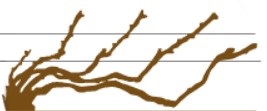
Chablis pruning is a mixed pruning technique known as "fan" pruning.
This pruning system is also used in Champagne.
Chablis pruning includes 1 framework at most per 30 cm, each of the frameworks bears a fruit extension at its end, 1 replacement spur known as a "rachet", pruned to a maximum of 2 free eyes, is left at the base of the stock[5].
Long pruning on short cane
Guyot pruning
This is the best-known long pruning method. Considered to be the most productive, Guyot pruning retains only the fruit-bearing buds (which are fertile). For this type of pruning, the quality of the bunches is preferred to the quantity produced. Production depends on the length of the cane and the number of buds. A cane of between 6 and 12 buds is selected and 1 or 2 booms are left below this cane to produce pruning wood for the following year. This type of pruning can be carried out using a short framework, but more often it involves a long framework with the cane attached to the trellising wire.
This system is often used in colder climates, and can be found in Alsace, Burgundy and Bordeaux.
This type of pruning also includes :
- Guyot simple bourguignon : with 1 spur with 2 eyes and, a little higher up, 1 rod with around 6 eyes.
- Double Guyot : used for high vines. With 2 spurs and 2 arched canes, with 10 to 12 eyes.
- Double Guyot Bordeaux : with 1 or 2 spurs and 2 flat canes.
- In Guyot mixte : 1 cane with 6 to 8 eyes on the left and 1 spur on the right, alternating each year.
- Guyot mixte nantais : 1 rod and 2 spurs spread over 2 or 3 arms.
- In Guyot Poussard Single Guyot pruning with 2 arms, one of which bears 1 spur and the second 1 rod and 1 spur, alternating each year.
Vallée de la Marne pruning
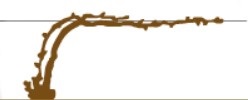
This pruning system is only used in Champagne for the Meunier grape variety.
The vines are pruned with 1 spur with no more than 3 free eyes per vine, 1 cane started on the previous year's spur and bearing no more than 9 free eyes, an extension (with fruit) established at the end of the previous year's cane and bearing no more than 6 free eyes[5].
The fruiting extension is tied horizontally at a maximum height of 0.50 metres above ground level.
Long pruning on a long frame
Lyre or U-shaped
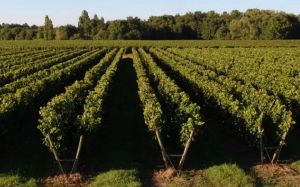
This high pruning is similar to the double cordon pruning except that the 2 arms are perpendicular to the row. This is the only pruning method on wide vines that gives good results. It takes its name from the two trellising axes which form a lyre. The two arms carry either spurs or long shoots, the branches of which are trained. This training system offers many advantages, including better aeration, better sunlight penetration and shade for the grapes. However, it requires more effort to install. It is found in the Hautes-Côtes-de-Beaune, Jura and other regions.
Other types of long pruning on a long frame :
- Courgée pruning : with arched canes. Technique used in the Jura.
- Cazenave-Ferret pruning : mixed pruning on cordon.
- Sylvoz pruning .
Each type of pruning has its advantages and disadvantages and is more or less adapted to different regions, soils and climates. You need to choose the method best suited to the location and grape variety, and decide whether quantity or quality is desired.
Different pruning methods
Whatever type of pruning is used, there are ways of maintaining it that will help the vine to be more resilient in the face of the stresses it will suffer over the course of its life : hail, frost, drought, but also fungal attacks and competition from weeds. Other methods will improve the quality of the grapes or reduce the workload.
Gentle pruning
Gentle pruning increases the vitality of the vines. Pruning that respects the physiology of the vine has a significant impact on wood diseases, and improves uniformity, plant health and grape quality. This is why, faced with the problems of decline in French vineyards caused in particular by wood diseases, some winegrowers are changing their pruning practices in favour of this method.
Soft pruning of the vine applies to all types of pruning : simple, mixed and double Guyots, cordon, gobelets lyre, etc.
For more information on this method, see the page on soft vine pruning.
Minimum pruning
Minimal pruning is the practice of not (or almost not) pruning the vine. The only pruning allowed in this type of vine management is trimming (in winter and summer).
The advantages are :
- Reduced workload and lower labour costs due to pruning.
- Improved aromatic quality of the grapes (richness of anthocyanins in the berries).
- Less attractive to pests.
- Less infection of pruning wounds, lessesca, lesseutypiosis.
For more information on this method, see the page on minimum pruning in viticulture.
Hedge pruning
Hedge pruning is the oldest simplified pruning method known and used throughout the world.[6]. It is a mechanised pruning system which consists of using a mechanical pre-pruner to make a more or less short pre-pruning on a high cordon. This reduces the cost and time required to prune the vines. However, there are no well-monitored trials in France to recommend this method, particularly because of the excessive crowding around the cordon and the associated quality and health risks.
For more information on this method, see the page on hedge pruning in viticulture.
Precision pruning
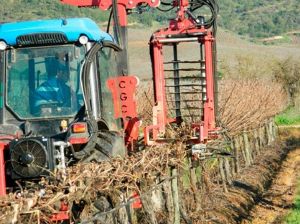
Taille Rase de Précision (TRP) is mechanised pruning taken to the extreme. It involves very short pruning to 1 or 2 buds (i.e. about 2 cm above the cordon) to create a pruning line that is renewed every year at the same height. The aim is to obtain a cordon that is as straight as possible, wrapped around the supporting wire to optimise mechanical pruning. Pruning time varies : between 2 and 4 hours per hectare for the machine.
Guyot or Royat cordon vines can be converted to TRP.
For more information on this method, see the page on Precision pruning in viticulture.
For more information on TRP, click here.
Vine management
Vine management covers everything that determines the appearance of the vine (vine stock and vineyard architecture) and the potential quality of the grapes.
Elements taken into account
- Planting density and geometry : Number of vines per hectare, spacing between rows and between vines.
- Training and renewal pruning, which varies from region to region : Authorised number of buds/m². Which pruning system will be used (goblet, cordon, Guyot, etc.).
- Pre-pruning : pruning of long shoots as soon as the leaves have fallen.
- Management of shoots : Shredding, burning, burying.
- The height of the trunk.
- Trellising methods and rules : when the trellising system should be in place.
- Tying : The phenological stage before which it must be completed.
- Tying up : The phenological stage before which it must be carried out at the latest. Tying up of strands held by wires may be compulsory.
- Height of foliage : The height of foliage after trimming is at least equal to 0.6 times the distance between rows. It is measured between the binder wire and the upper limit of trimming.
- The various operations carried out on the vines (green harvesting).
- The average maximum load on the plot : The maximum number of kg/ha of grapes. The number of bunches/m² of vine surface in production.
- Missing grapes threshold : The authorised percentage of dead or missing vines.
- Thestate of the vines : General health and maintenance of the soil.
- Earthing-up/earthing-out (cavaillonnage/décavaillonnage or chaussage/déchaussage) : To protect the vine from frost.
Other cultivation practices
Other terroir-related practices are also worth studying :
- The green manures.
- Permanent grass cover between rows and on headlands.
- Theuse of composts and organic household waste, and sewage sludge other than from wine-making installations, alone or mixed.
- The use ofherbicides on the row and between the rows.
- The use ofinsecticides and fungicides.
- Working the soil.
- Irrigation : installation of ditches and keylines.
- The vitiforestry.
- The sheep grazing.
- The animal traction.
- The vineyard renewal The renewal of the vineyard: replanting, grafting, planting new vines or grubbing up and replanting the entire plot.
For example, here is the decree for the"Champagne" AOC.
Everything about vine management is closely linked to the grape variety, the climate and the type of vineyard.
Different management systems
The assessments given below are valid for the Occitanie region[7]. The more "+", the more advantageous the system and the more "-", the less advantageous the system.
Free
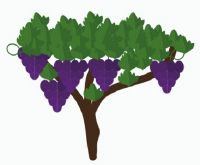
Applies to goblet pruning.
For an average planting density :
- Potential quality : +
- Yield : +
- Cost : --
Trellised espalier
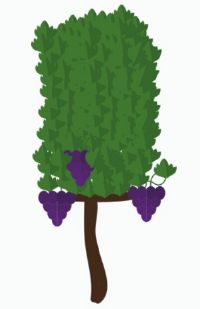
Applies to single or double Guyot pruning, cordon pruning, etc.
For a low planting density :
- Potential quality : -
- Yield : +
- Cost : ++
For medium planting density :
- Potential quality : +
- Yield : +
- Cost : +
For a high planting density :
- Potential quality : +
- Yield : +
- Cost : -
Lyre
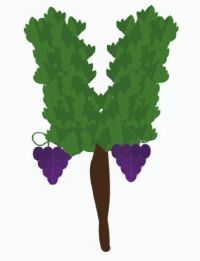
For low planting density :
- Potential quality : ++
- Yield : +
- Cost : -
Deployed

For low planting density:
- Potential quality : +
- Yield : +
- Cost : +
Pergola
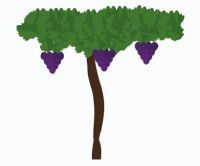
For a low planting density :
- Potential quality : +
- Yield : ++
- Cost : -
Minimum pruning
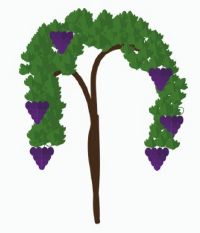
For a low planting density :
- Potential quality : +
- Yield : +++
- Cost : ++
For a general and chronological overview of the annual work carried out by winegrowers, click here.
Late pruning
Faced with climatic disturbances and major frosts in the spring, some winegrowers are pruning their vines late to increase the resilience of their plots. Late pruning involves techniques based on a deliberate delay in carrying out traditional operations. This helps to delay over-accelerated or unbalanced ripening of the grapes. To find out more about this technique, click here.
Estimating pruning and management costs
The IFV has set up the VITICOÛT tool, which gives an idea of the costs associated with the vine management chosen.
Sources
- Wikipedia page on vine pruning
- Guyot pruning, Royat cordon pruning, goblet pruning, etc. - Dico du vin
- The different ways of pruning vines ? - Bunches
- The main management systems : advantages and disadvantages - IFV
- ↑ Brèves de Ballan - Régis Chaigne, Pruning the vine - a time-consuming operation that determines the future harvest and longevity of the vine, 17 February 2008. http://www.chaigne.fr/blog/180-la-taille-de-la-vigne-une-operation-longue-qui-determine-la-future-recolte-et-la-perennite-de-la-vigne
- ↑ 2.0 2.1 Vine pruning, Academic, https://fr-academic.com/dic.nsf/frwiki/1601681#:~:text=Cazenave%2Dferret%20%3A%20c'est,Taille%20L%C3%A9pine.
- ↑ Michel Gassier, Un gobelet pour la taille, 20 January 2014,https://www.domainegassier.com/fr/2014/01/20/un-gobelet-pour-la-taille/.
- ↑ Chambre d'agriculture Languedoc-Roussillon, Trajectoire Références Techniques : Cabernet, March 2006, https://occitanie.chambre-agriculture.fr/fileadmin/user_upload/National/FAL_commun/publications/Occitanie/Trajectoires_n_16_cabernet_franc.pdf
- ↑ 5.0 5.1 Decree no. 2010-1441 of 22 November 2010 on the registered designation of origin ' Champagne ', https://www.legifrance.gouv.fr/loda/id/JORFTEXT000023126020/
- ↑ CARBONNEAU A., 2014, "Simplified" pruning is the key for many vineyards : but which ones ?
- ↑ IFV Occitanie, The main management systems : Advantages and disadvantages, https://www.vignevin-occitanie.com/fiches-pratiques/systemes-de-conduite/